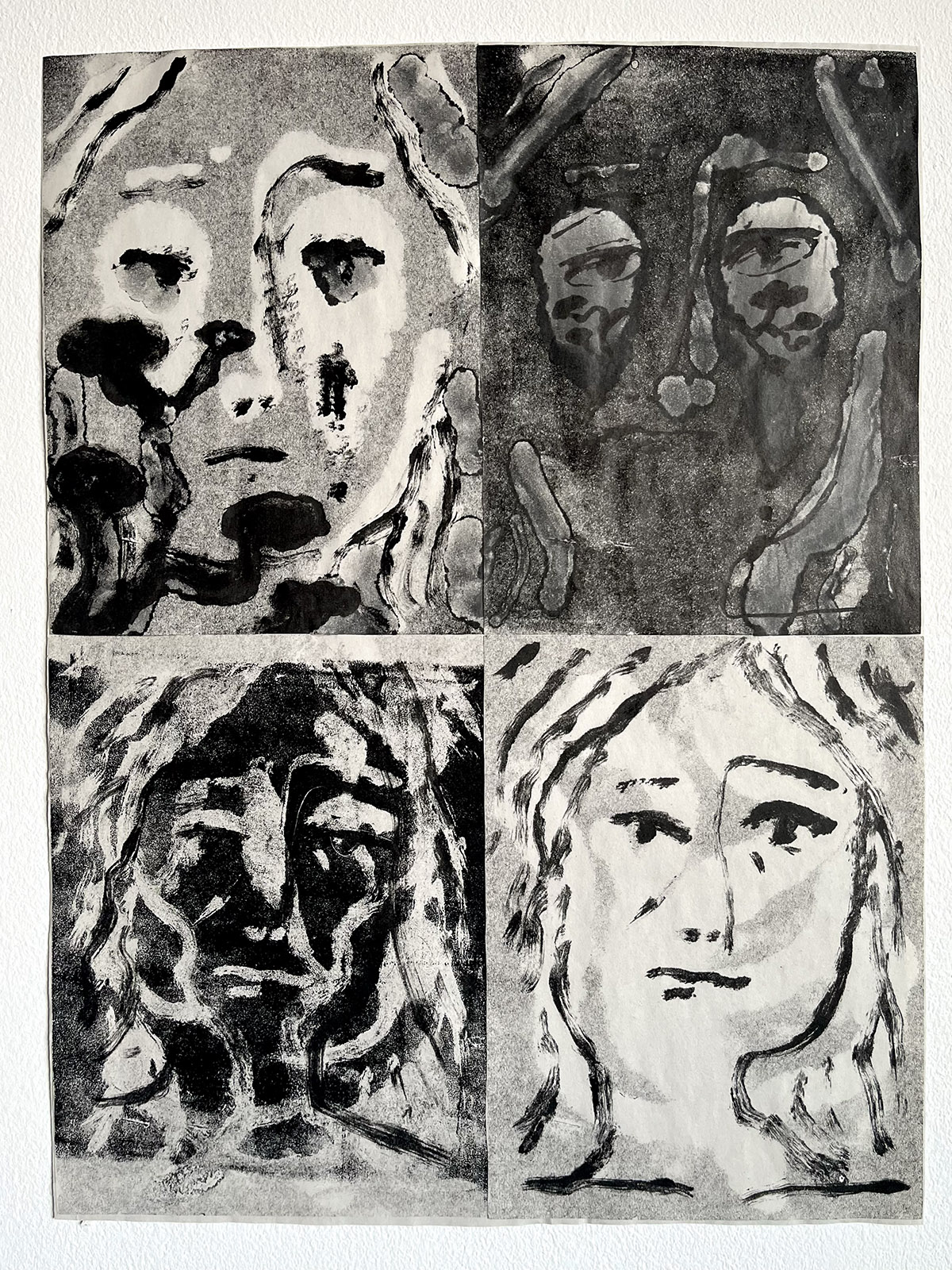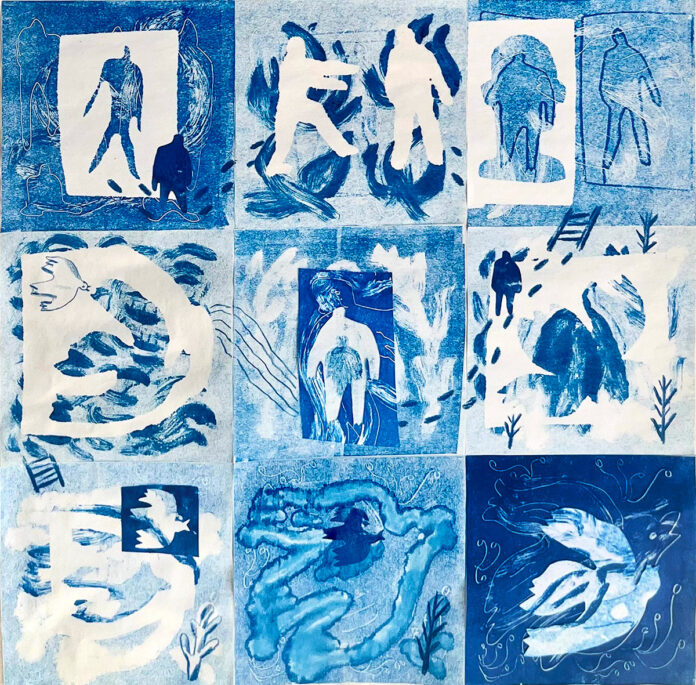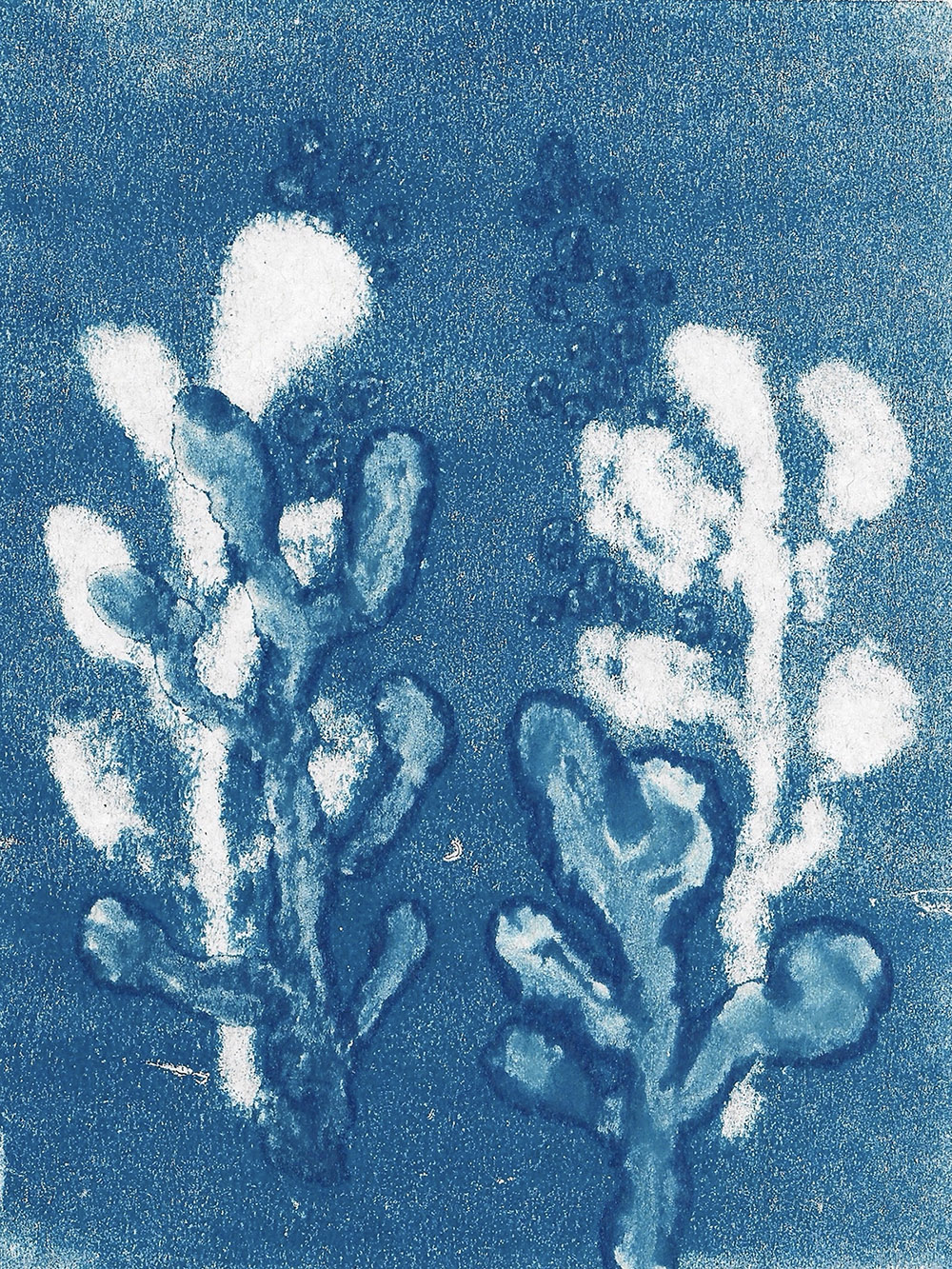Caijing Kuang’s prints feel like the inhalation of a quiet room. You don’t notice the change at first — not right away– but something softens. Something shifts. And then you are in it.
Her work does not speak in grand absolutions. It whispers. It wanders. It occupies that invisible space between image and memory, between seeing and feeling. Be it the layered inscape of Growing in Blue; the solitary hush of Shadow; or the spiral of ache in Voice; Kuang’s prints ask something rare from us as viewers. Not to be interpret, nor to even understand, but simply to sit with what stirs.
There is a kind of emotional magnetism that draws you to what she is doing — a feeling that her monoprints are not simply made but excavated. The texture, the human frailty, the tattered edges of her figures — they all feel like something half-remembered, something that has come to the forefront from somewhere just below conscious thought.

Growing in Blue, her nine-square monoprint, is the clearest window into her visual language. Each square is a scene different from the others, collected as from pages of a dream journal left in the rain. Human silhouettes move between watery brush strokes. Birds drift among forms, some whole and some not; all pausing in moments that haven’t quite resolved. There are ladders without endings, footsteps without destinations, and limbs that belong to no-one, yet somehow everything feels right. None of it is lost. Everything seems to exist exactly in its right place — not in respect of narrative, but of feeling.
It’s in this space — this fragmented, floating, emotionally open space — where Kuang’s gift really lives. She understands something that can’t be taught: that the body holds memory in pieces, and that sometimes, the act of creating is less about clarity and more about holding space for what can’t be named.
While still feeling it intensely in Shadow, the figure remains both present and dissolving. The ink has faded just enough to obscure her features, to blur her edges – and yet, that absence presents itself louder than presence. You don’t need to see her face. You know her. Or maybe more correctly, you feel the part of yourself that is her. The part that has been hidden, forgotten, or simply allowed to wear thin with time.
This is where Kuang separates herself from the decorative or the illustrative. She produces prints that are emotional mirrors. You do not look at them within the context of outside viewing, you enter into them.
In Voice, there is a shift – the palette deepens, the shapes grow looser, and more abstract. In the center is a spiral, dark blue, intense, and pulsing, and inside it are possibilities of a bird, or a breath, or a thought that you just can’t put a name to. It doesn’t matter. Kuang isn’t illustrating a concept, she is working with a sensation. There is tension in that spiral – not panic, but an intimacy, a closing in, like if you were to listen too closely to your own heartbeat.
What makes her work so destructive is not only emotional weight, it is how lightly she rides it. These are prints done with air and silence, with smudges and gently applied pressure. There is nothing over-rendered or over-worked. She simply trusts the medium to say what it needs to say. She trusts us, the audience, to meet her halfway.
That trust is crucial, because her themes are not easy ones. Kuang navigates memory, lost, and displacement, and identity by inviting us, the viewers, on the journey with her, with a calm bravery. Critical to her practice is that she simply gives us an experience of these themes without necessarily needing to articulate them to us. There is no manifesto here and no didacticism, just feeling — layered, contradictory, unarticulated feeling. She captures the rhythm of remembering: how it loops, how it gets stuck, how sometimes it can feel light and sometimes it feels heavy.
You can see her cultural background bleeding into the work in a beautiful way — not as decoration, but as emotional infrastructure. The plants that are threaded through her prints hold more weight than just symbolic motifs. They stand in for breath, survival, becoming. Growing up in the mountainous province of Guizhou, Kuang has spiritual residue from that landscape that feeds into her cluster of memories — time unfolds readily around trees, nature carries stories. Her use of flora is not symbolic in the Western sense, but visceral. These are not metaphoric — they are memory, with roots.
And when you see those branches weaving around a body or those leaves mingling with footsteps, you do not say, Oh that means healing, you just feel it. In your chest. Like a truth you already knew.
There is something incredibly generous about her process. The chaos of monoprinting – the ways ink is unpredictable, in how textures appear uninvited, is reflective of the emotional landscapes she is navigating. She does not push against the medium and instead, allows the medium to speak. Their relationship of impulse and control becomes a kind of remarkable visual understanding.
And this is why her work continues to gain traction — not because it is fashionable or polished, but because it is real. You cannot fake what she is doing. You cannot teach it. You can only feel your way into it — and she has. Completely.
And yes, the art world is taking notice. From the World Illustration Awards shortlist to exhibitions in the UK and France, Kuang is certainly in the rising star spotlight that is well deserved. But I think as pertinent, she is creating something that many contemporary artists struggle to achieve: work that does not demand your attention, but captured it. Work that does not perform feeling, but embodies feeling.


